Force of Friction
- Books Name
- Class-8 Science Book
- Publication
- PathSet Publications
- Course
- CBSE Class 8
- Subject
- Science
Force of Friction
What is Friction?
FRICTION- It is a force that resists the relative motion of surfaces.
What is Friction?
The force, which opposes the relative motion between two surfaces in contact is known as friction. It occurs due to surface irregularities of the two objects in contact.
What are Surface Irregularities?
This unevenness of the surface is called surface irregularities or roughness.
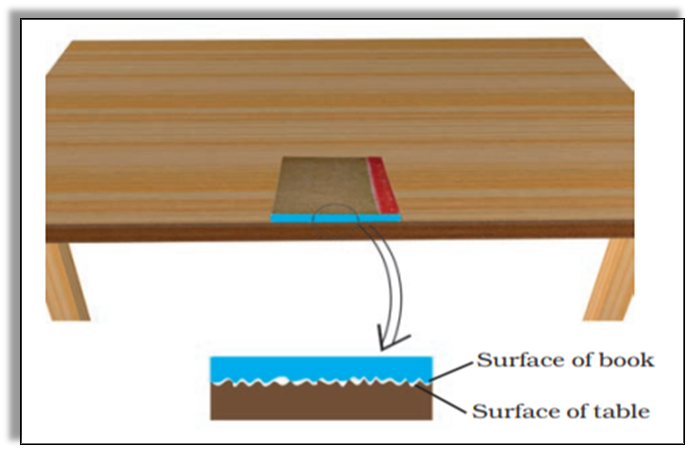
- All types of surfaces like solid, liquid, and air offer the force of friction.
- This force of friction always opposes the applied force.
- When two objects with their surfaces in contact rub against each other, they cause friction
- Friction is the force opposite to the direction of motion.
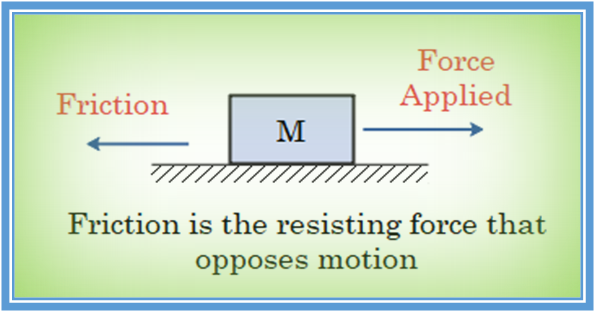
- Friction is the force that acts when one object tries to move or slide over the surface of another object.
- It can be defined as the resistance of motion when one objects rub against other.
- Friction works against the motion and acts in the opposite direction. However, friction does not always oppose the motion, it also helps in motion.
- The S.I unit in which Frictional Force is measured in Newton.
Examples –
- Friction between the tyres of vehicles and the road. A moving tyre on the ground stops after covering a certain distance because the surface of the ground offers opposite direction friction to the surface of the wheel in motion.
- Gently pushing a book on a table. It stops after moving some distance because of friction between the surfaces of the book and table.
- Writing on paper using a pencil. Friction between the graphite in a pencil and a sheet of paper leaves a mark on the paper. Same there is a Friction between pen and book.
- Warming hands in winter. As friction produces heat you can warm your hands in winter by rubbing them against each other. So heat from friction can be useful.
- Gymnasts apply some coarse substances on their hands to increase friction for better grip
- To make the box move, we have to apply a force to overcome the force of friction.
Cause of Friction
- The root cause of friction is the irregularities or rough edges that are ridges and grooves present on the two surfaces which are in contact. Due to this they get interlocked with each other and cause friction.
- Even smooth surfaces like tiles in houses, offices, schools have a large number of irregularities when seen under a microscope.
Why is it difficult to walk on a smooth or wet floor?
Due to less friction between our foot and floor. As the interlocked irregularities possess a layer of water which decreases friction.
What Causes Friction?
Friction exists between two surfaces due to abnormalities on the surfaces of the objects in contact, as well as the interlocking of the two surfaces' micro-level imperfections. So, this force is caused by molecular adhesion, surface roughness, plowing effect, and deformations.
Factors affecting Friction
- Books Name
- Class-8 Science Book
- Publication
- PathSet Publications
- Course
- CBSE Class 8
- Subject
- Science
FACTORS AFFECTING FRICTION
- Friction is caused by the irregularities on the two surfaces in contact.
- Even those surfaces which appear very smooth but microscopic view show those irregularities.
- The irregularities of the two surfaces get interlocked. We have to apply force to remove the interlocking.
- So the force of friction is greater if a rough surface is involved.
- The friction force will increase with the increase in weight. Example: It is easier to drag a mat when nobody is sitting on it than a person is sitting on it because friction increases with an increase in weight.
- Rougher surface offers more force of friction.
- It acts in a direction opposite to the direction of motion.
- It depends on the mass of the body.
- It depends on the surface's nature, as smooth surfaces have fewer irregularities and thus less friction. As a result, moving an object to a smooth surface is easier than moving an object to a rough surface
Which one is easier to hold in hand: An Earthen Pot or a Glass Tumbler. Why?
Because of the smoother surface, the Glass Tumbler creates less friction and it is not easier to hold. On the other hand, an earthen pot has a rougher surface which creates more friction and thus makes it easier to grip.
Factors that can affect Friction
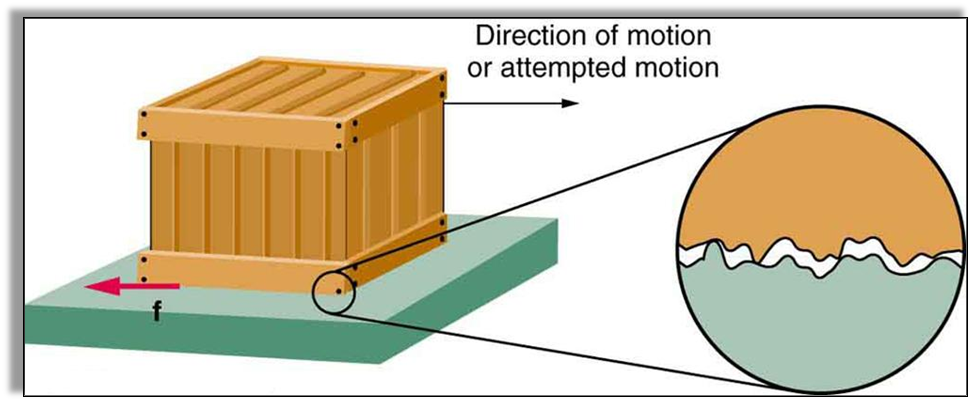
- The irregularities of a surface: If we move an object with has an irregular or rough surface on another surface that is also irregular, the force of Friction will be high in this case and the movement of the object would be restricted.
- The regularity of a surface or its smoothness: If the surfaces of either the object are smooth, the force of Friction would be less and the object would move easily over the surface. Even smooth surfaces have a certain irregularity.
- If two surfaces are pressed hard: the force of Friction increases between two surfaces if they are pressed hard and hence the movement of the object becomes restricted. However, if there is no pressure the object can easily move.
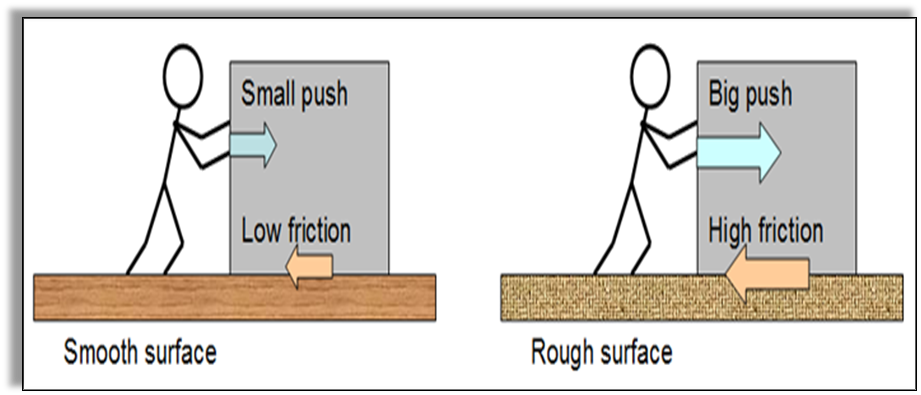
Friction: A Necessary Evil
- Books Name
- Class-8 Science Book
- Publication
- PathSet Publications
- Course
- CBSE Class 8
- Subject
- Science
FRICTION: A NECESSARY EVIL
Friction is a necessary evil because it is both harmful and beneficial effects in everyday life.
Friction is necessary. Without friction -
▪ No moving object can stop.
▪ No building can be constructed.
▪ We will not be able to write with pen or paper.
▪ We will not be able to walk.
Friction is evil because:
- Friction wears out the materials whether they are screws, ball bearings, or sole of shoes.
- Friction produces heat causing wastage of energy in machines.
- Friction causes moving objects to stop or slow down.
Examples:
- Soles of shoes have grooves on them. Grooved soles provide more friction to the ground which gives better grip when we walk.
- We can walk easily because the ground offers friction. So, friction is necessary even in a simple task like walking.
- It is a difficult task to move on a wet muddy track or wet marble floor. This is because these surfaces offer very small friction to the surface of the feet of a person.
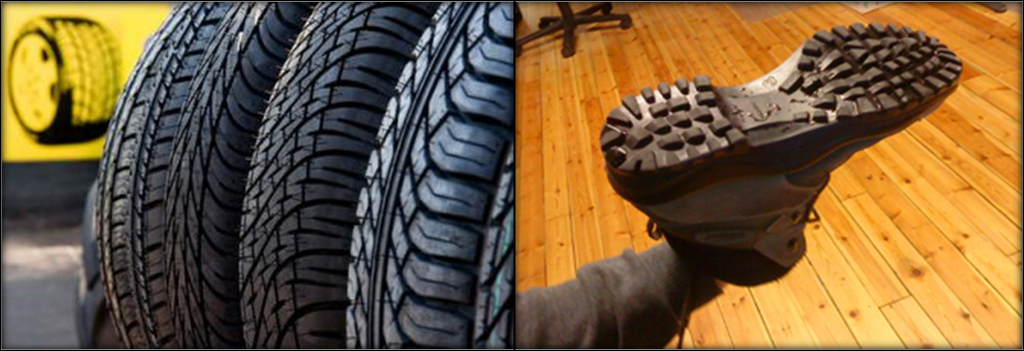
Increasing and Reducing Friction
- Books Name
- Class-8 Science Book
- Publication
- PathSet Publications
- Course
- CBSE Class 8
- Subject
- Science
Increasing and Reducing Friction
Increasing Friction:
Sometimes we need to increase Friction so as to avoid slipping of objects, for Example:
- The sole of the shoes is grooved so that the Friction between our feet and ground increases and we can walk safely.
- The tyres are treaded so that they can have a better grip over the ground and allow the smooth movement of the vehicles.
- Brake pads are used in bikes to stop them suddenly from moving by increasing the amount of Friction.
- Kabaddi players rub their hands with soil which helps in increasing the Friction between the hands and allows them to have an easy grip on the opponent.
- Gymnasts also apply a coarse substance so that they can have a better grip due to increased Friction in their hands.
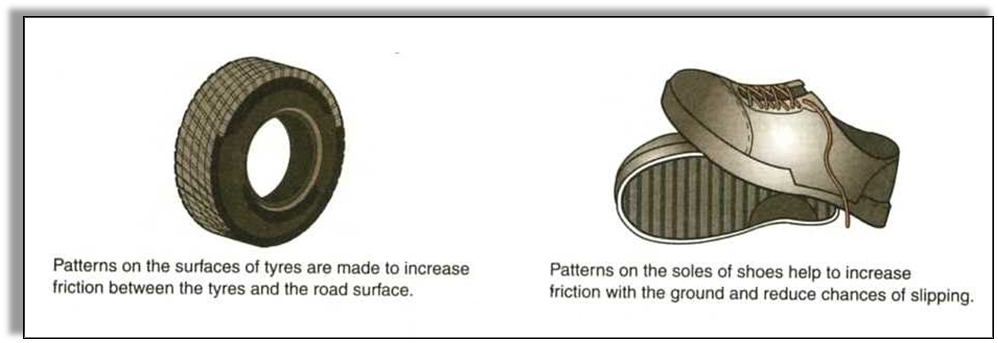
Friction is desirable in many situations. Friction is necessary for us. Therefore, Friction is increased to accomplish some important tasks. for example:
- Treaded tyres of vehicles increase friction. A vehicle with treaded tyres provides more friction which gives a better grip on the road.
- Kabaddi players rub their hands with soil for a better grip on their opponents.
- Soles of shoes and tyres are treaded to increase friction. This provides a better grip on the ground.
- Friction is increased by using brake pads in the brake system of bicycles and automobiles. These pads arrest the motion of the rim due to friction.
- Gymnasts apply some coarse substances on their hands to increase friction for better grip.
- Javelin's thrower rubs some powder on his palm to get a better grip on the javelin.
- Soles of shoes are treaded to increase friction between the sole and the ground.
Reduction of Friction
Friction is reduced in order to increase efficiency. When a few drops of oil are poured on the hinges of a door, the door moves smoothly.
Examples: Oil, grease, or graphite.
In Some cases, friction is not desirable. We need to reduce it. Make sure that the interlocking of irregularities is avoided to a great extent and movement becomes smooth.
The substance which helps to reduce friction is called Lubricants. It makes a thin layer over the surface and facilitates smooth movement.
Example-
- In the engines of vehicles use of lubricants increases the efficiency as parts are not rubbed directly at each other because of a thin layer of lubricant.
- In many machines, graphite powder, oil, grease are used as lubricants for reducing friction.
- The powder is sprinkled over the carrom board to decrease the friction between the board’s surface and the striker. In this way, the surface of the carrom board becomes smooth.
- Grease is used in bicycles and other motors or different parts of a machine to reduce Friction and increase their efficiency.
- Oil is applied on the hinges of the door so that they can move easily.
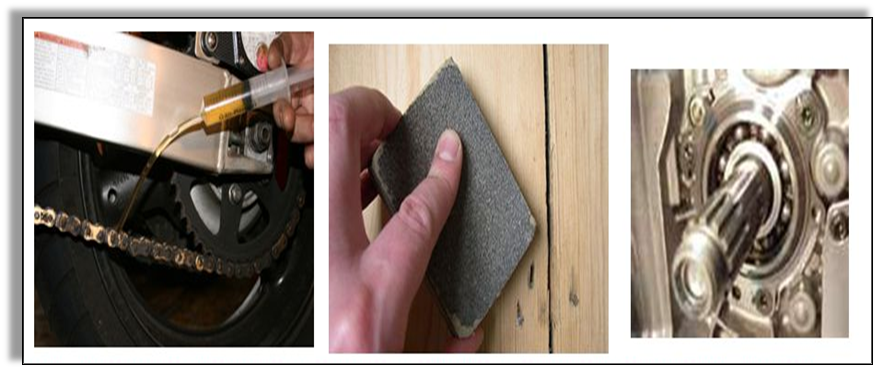
- Applying substances like oil, grease or powder allows for smooth movement as they block the irregularities of a surface. The substances that can reduce the amount of Friction between different objects are called lubricants. However, we can never reduce Friction to a level of zero. There are always some irregularities present on the surface.
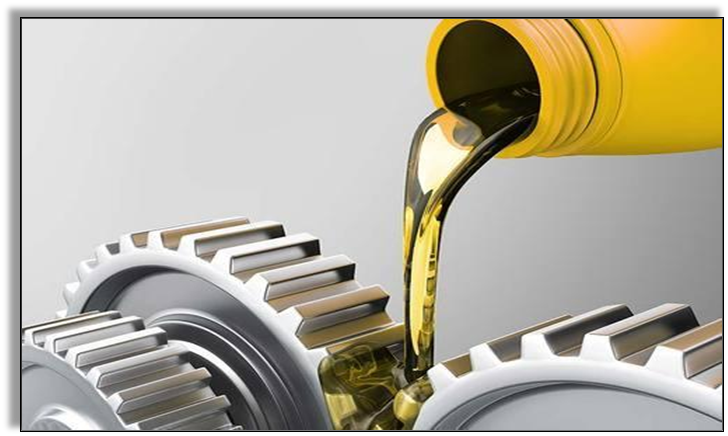
Wheels Reduce Friction
- Books Name
- Class-8 Science Book
- Publication
- PathSet Publications
- Course
- CBSE Class 8
- Subject
- Science
Wheels Reduce Friction
How Wheels Reduce Friction?
- We know that when an object rolls over a surface rolling Friction is produced which resists its motion on the surface. However, its magnitude is lesser than the static and sliding friction.
- Wheels are circulating objects that turn around a center point.
- The wheels allow an object to roll over a surface rather than allowing them to slide over the surface.
- This results in less Friction and hence the easy movement of the object.
- Rolling Friction is also used in the parts of machines that are moving continuously.
- In this way, the sliding Friction is removed with the help of rolling Friction, and therefore the adverse effects of Friction such as the production of heat or wear and tear of the mechanical parts are also reduced.
- For instance, ball bearings are being used in fans and bicycles to reduce Friction.
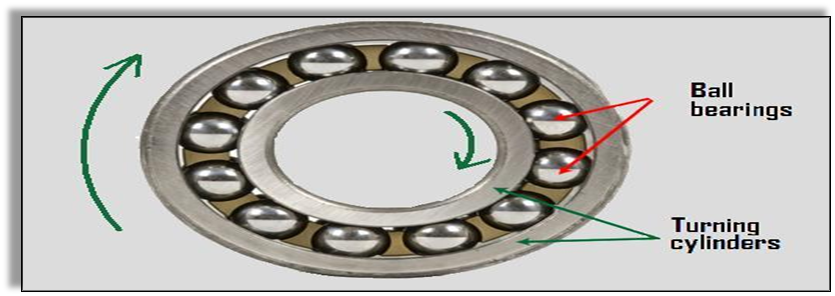
Fluid Friction
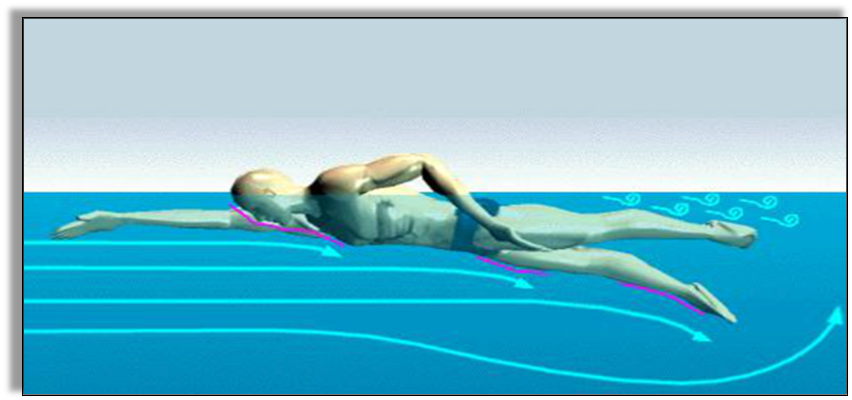
- Air, water, and other liquids collectively are called fluids. They also exert a Frictional force on the object that travels through them. Such a Friction is called fluid friction or drag. The amount of Frictional force by a fluid on an object depends upon the following:
- The speed of the object with respect to the fluid.
- The nature of the fluid, its viscosity, or its tendency to resist the flow.
- The shape of the object.
Fluid Friction comprises Internal and External Friction:
- Fluids comprise internal Friction that occurs between the molecules of a liquid as they are also in motion. The viscosity of a liquid, therefore, depends upon the internal Friction.
- An external Friction in fluids is the force exerted by the fluid on the object that flows through it.
- As an object travels in a fluid it loses its energy in order to overcome the fluid friction. Hence, things that can easily flow in fluids have special shapes.
- For instance, ships and boats have a particular shape that allows them to resist fluid Friction.
- Birds and airplanes have a specific shape that allows them to fly in the air.
- Fishes also have a specific shape such as a tail and fins that allow them to swim continuously in water and even prevent the loss of energy due to fluid Friction.
- Not only this, all the vehicles are designed in a way that they can resist fluid Friction because air is present everywhere.
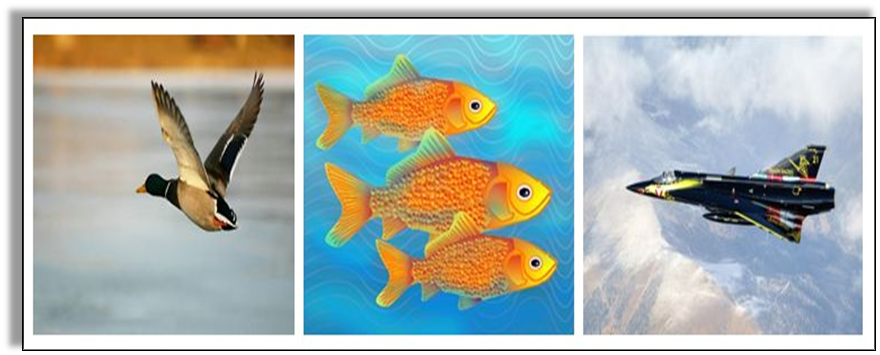
Types of Friction
- Books Name
- Class-8 Science Book
- Publication
- PathSet Publications
- Course
- CBSE Class 8
- Subject
- Science
Types of Friction
There are four types of friction namely
1. Static friction
2. Rolling friction
3. Sliding friction
4. Fluid friction
1. Static friction
- The word static means at rest.
- Static friction can be defined as the friction that acts when we try to move an object at rest or the object which is not moving. It is the strongest type of friction.
- For example –
- Cup placed on a table
- Scenery hanging on a wall
- A car parked on a hill.
- Limiting friction is the friction acting on a body when it is about to start moving.
2. Sliding friction
- Sliding friction is smaller than static friction as a smaller force is now required to keep the object moving.
- Sliding friction can be defined as the friction that acts when two surfaces slide over each other.
- If the applied force exceeds the limiting friction the irregularities on it do not get interlocked on the surface on which it is moving.
3. Rolling friction
- Rolling friction is always less than sliding friction as rolling reduces friction. Rolling friction is the weakest type of friction.
- Rolling friction can be defined as the force that opposes the motion when an object rolls over another object.
For example –
- Ball bearings
- Skateboards
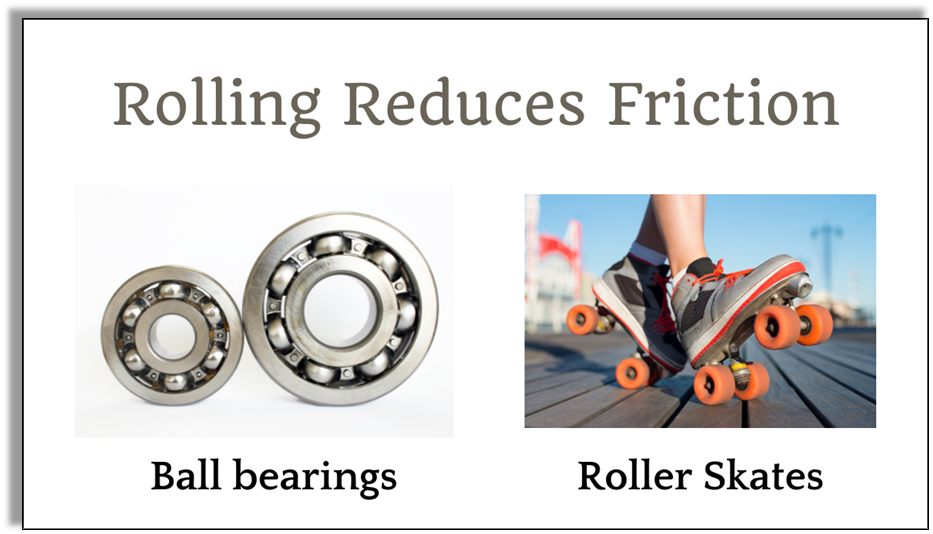
4. Fluid Friction
- The above three friction occur between solid surfaces whereas fluid friction occurs in fluids, that is in liquids or gases. A fluid is a substance that can flow and take the shape of a container.
- Fluid friction can be defined as the friction that occurs when objects move across fluids. Another name for fluid friction is drag. It resists the movement of viscous fluids relative to each other.
- The force exerted by fluids is called drag. Drag force acts in a direction opposite to the direction of motion of the object. For example - When an airplane moves at a high speed it experienced air resistance.
- Fluid friction depends on the following factors
- Speed of the object for the fluid.
- The shape of the object.
- Size of the object.
- Nature of the fluid.
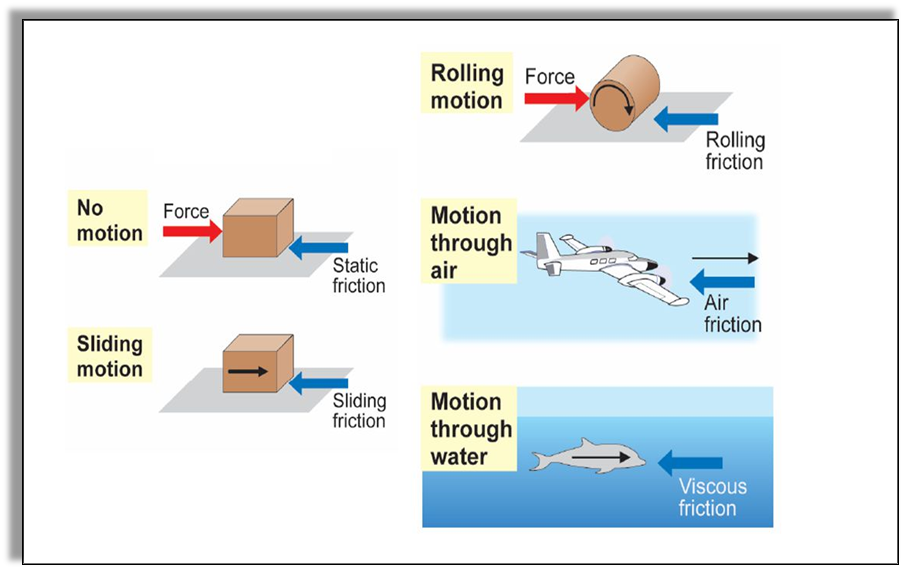
Advantages of Frictional Force
- The frictional force is necessary for various purposes in our daily lives such as:
- It allows us to walk on the earth's surface.
- It allows us to write with a pen on a surface or a paper.
- It allows us to fix a nail in the wall.
- A moving object would never be able to come to a state of rest without the Frictional force.
- It would not be possible to drive any automobiles on the road without the Friction force.
- It would not be possible to construct any buildings without the Frictional force.
Disadvantages of Frictional Force
- Frictional force results in wear and tear of objects such as the moving parts of a machine, the tyres of a vehicle, the sole of the shoes, etc.
- It also results in the production of heat. In the case of machines, the production of heat leads to the wastage of energy.
- The Frictional force also leads to a decrease in the speed of a moving object or sometimes stops it.
- It can lead to noise pollution in certain cases. For instance, aircraft produce loud sounds due to the resistance of the air.
Ways to Reduce Fluid Friction
- Firstly the question arises that why there is a need to reduce fluid friction.
- As when objects move through fluids, they lose some of their energy in overcoming the fluid friction which decreases the efficiency of an object. To overcome this there is a need to reduce fluid friction.
- Fluid friction can be reduced by molding the shape of an object which offers little resistance to fluids. The streamlined shape is best suited for objects that move in air or water. The streamlined shape is like a thin wedge that cut the air or water and moves forwards.
- For example – An airplane has a special shape called streamlined shape to reduce friction offered by air. Similarly, boats, birds and fishes have this special and suitable shape to reduce fluid friction and avoid loss of energy.
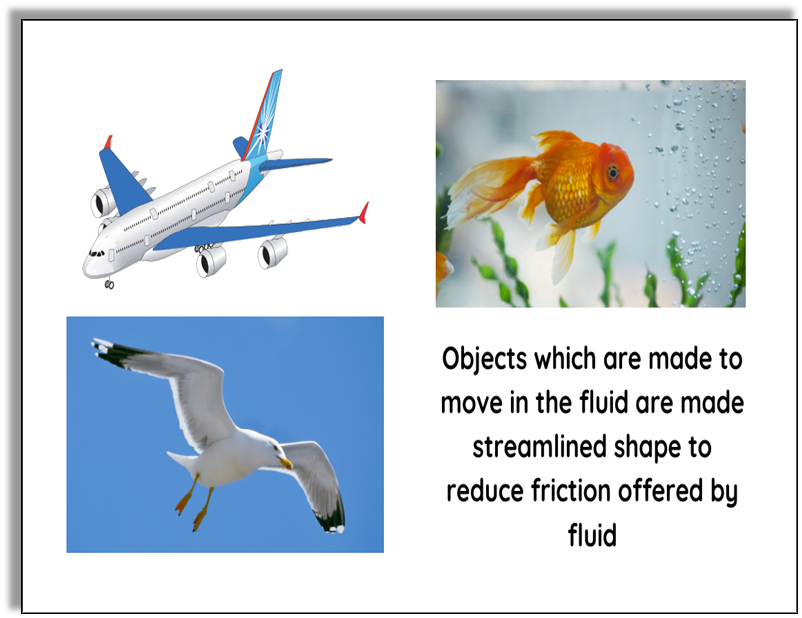

 PathSet Publications
PathSet Publications
